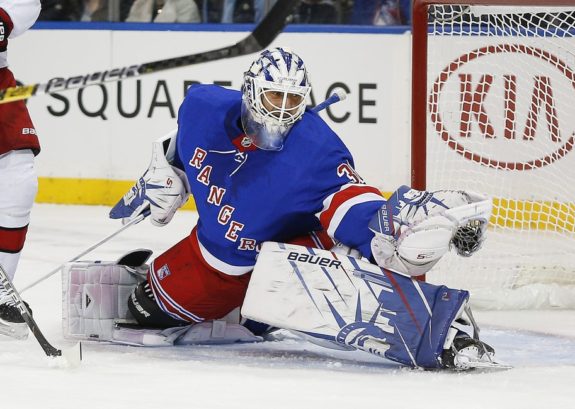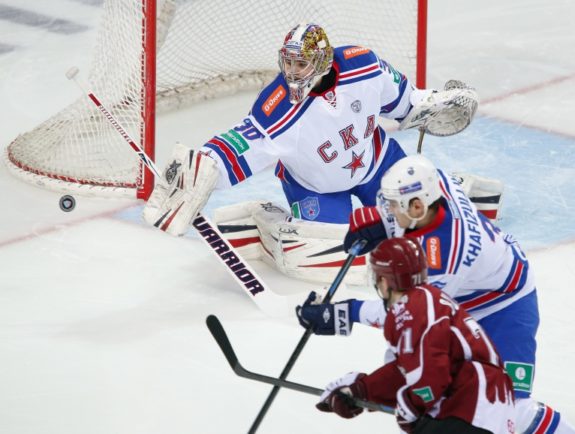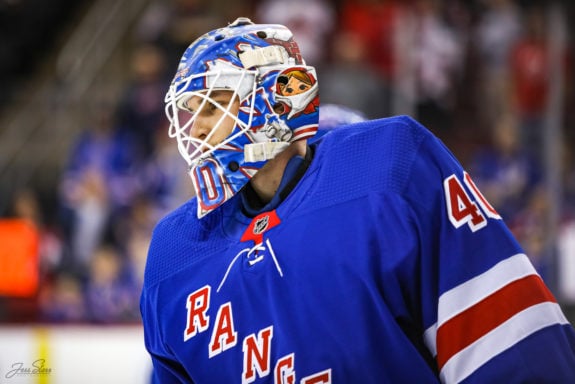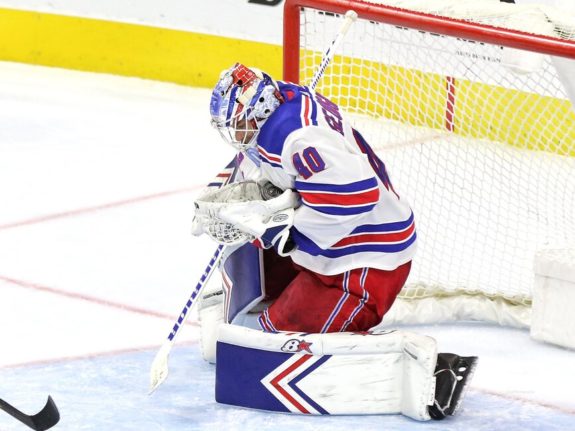Trivia question: Who was the last New York Rangers goaltender not named Henrik Lundqvist to start more than 50 games in a season?
The answer: Mike Dunham with 57 in 2003-04, one season before The King made his debut on Broadway. That actually came in 2005-06 after the 2004-05 season was lost to a lockout. Lundqvist played in 53 games as a rookie, going 30-12-9 with a 2.28 goals-against average (GAA) and two shutouts as the primer to his Hall of Fame career.
Since then, the fifth-winningest goalie of all time has never played fewer than 52 games in a full season. He’s been the Rangers’ best player throughout his 15 seasons, more responsible than anyone else for several years of Stanley Cup contention for a good-but-not-great roster. Lundqvist is destined to go down as an all-time New York City athlete with his jersey hanging in the Madison Square Garden rafters, even if he ends up in the Patrick Ewing category: A beloved Hall of Famer who never won a championship.
That’s why having thoughts of moving beyond the Lundqvist era feels so wrong.

The Rangers, though, need to start thinking seriously about doing just that – and soon. For their rebuild, now in full swing, has not fully extended to the net of their beloved King – and sad as it may be in such instances, his presence could end up delaying and even hurting the process into which the Rangers have otherwise jumped with both feet.
Reconstructing a team never goes 100 percent as foreseen, of course. The Rangers certainly had a plan: Approaching Lundqvist upon announcing the intention to turn over the roster and start anew in Feb. 2018, the front office asked if he wanted to be a part of the reconstruction or preferred to go elsewhere to finish up his career, with the hope of chasing the Cup again with a contender.
Rangers’ Post-Lundqvist Plan Got Complicated
Lundqvist said no, told management that he remained all-in with the Rangers and wanted to be around to help lead them back to the playoffs. It was hardly a surprising answer from a player who loves playing in New York with the only team he’s ever known.
The Rangers wouldn’t be unprepared for the end of Lundqvist’s contract after the 2020-21 season. Igor Shesterkin, the organization’s top prospect, was in the midst of his second straight season of domination in the Kontinental Hockey League, and the club figured the timing for his NHL arrival would conveniently coincide roughly with Lundqvist’s departure.

Shesterkin has done nothing but burnish his prospects since, as he made the jump to North American hockey and the American Hockey League this season, going 10-3-3 with a 1.92 GAA in his first 16 games with the Hartford Wolf Pack. The problem that has emerged with the plan – either a pleasant or inconvenient one, depending on how it’s viewed – is the fact that the Rangers just might have Lundqvist’s successor on their roster already.
Alexandar Georgiev has risen from an undrafted player who was invited to the Blueshirts’ developmental camp in 2017 to potential top goaltender status for an NHL team. Whether it’s the Rangers remains to be seen.
The league’s first Bulgarian-born player is 26-22-6 with a 2.89 GAA and four shutouts in 58 games over three seasons. Two of those blankings have come in his last five starts, including a 38-save effort in a 5-0 victory over the Vegas Golden Knights on Sunday, Dec. 8. He’s outplayed Lundqvist, who has a 3.13 GAA, by posting a 2.69 mark in 15 games in 2019-20. Lundqvist started Saturday against the Anaheim Ducks and made 39 saves, but allowed a soft power-play goal to Hampus Lindholm that tied the game with 1:46 remaining en route to a 4-3 shootout loss.
Georgiev is poised, positionally sound in net and quickly forgets about goals he’s allowed. He had given up four goals over four starts before allowing three on 18 shots Thursday, nevertheless beating the San Jose Sharks 6-3. Originally seen as a capable backup to Lundqvist and pleasantly surprising depth until Shesterkin was ready, Georgiev is now forcing the Rangers to reconsider how to proceed with their future in goal.
Part of the “problem” is that Shesterkin is ready, at least to begin getting a taste of the NHL. He’ll turn 24 on Dec. 30, so he’s not a kid anymore. If the Rangers want to completely advance their youth movement, Shesterkin needs to make his way to Broadway soon, preferably this season.
The ideal way to do that? Well, it would be as Lundqvist’s understudy, with Shesterkin gradually shouldering more and more of the workload over this season and next to get a sense of his abilities and hopefully, prepare him for the eventual transition to No. 1 goalie when Lundqvist departs.
Whether they are aware of it or not, the Rangers have followed that plan to a T – with Georgiev.
No Guarantees Shesterkin Will Find Stardom
Ten months younger than Shesterkin, it’s Georgiev whose game and confidence – not something he was lacking to begin with – have grown with the invaluable apprenticeship to The King over the past three seasons. And the widely speculated-solution to the issue of having three goalies for two spots could prove to be a disastrous one in the long run.

That supposedly simple course of action: trade Georgiev at the deadline to a goalie-desperate team. While that would open up the backup spot behind Lundqvist for Shesterkin to be called up and start his NHL apprenticeship, doing so would be taking on more risk than perhaps the Rangers would like to admit.
Shesterkin, after all, is a prospect, not a lock to establish himself as a top netminder. Moving out the young and improving Georgiev, who’s at least partially proven himself to be an NHL-level talent with the proper mindset to succeed at the highest level of hockey, would amount to the Rangers betting their future on Shesterkin’s potential translating into stardom.
There are, of course, no guarantees with young players and the trajectories they take during their development. Rangers forward Vitali Kravtsov, the ninth overall pick in the 2018 draft, was among the team’s best players at the Traverse City tournament prior to the season. He nearly made the roster out of training camp but was sent to Hartford instead to start the season. There, he struggled and exercised a clause in his contract to return to the KHL in late October. Kravtsov had trouble in that league as well and was demoted to the remote VHL before the Rangers took steps this week to bring him back to North America in something of a reset.
The talented Kravtsov may still very well have a bright future on Broadway, but at the very least, the timeline for that to happen has been extended indefinitely. The lesson should be clear: There’s a long way to travel from highly regarded prospect to NHL regular.
Should Shesterkin not take a straight path to No. 1 goalie – if he arrives there at all – and a traded Georgiev does, the Rangers will have unintentionally done away with a player whom they spent three seasons steadily developing and who was starting to show signs of taking the next step as a result.

The Rangers have dealt away some goaltending talent in recent years, selling off Cam Talbot to the Edmonton Oilers after the 2014-15 season for draft picks, and Antti Raanta to the Arizona Coyotes following 2016-17 as part of the Derek Stepan trade. Both goalies found success after being dealt, but the decisions to move both were easy ones for the Rangers, with Lundqvist on top of his game and the club still in playoff-contention mode.
Should Rangers Again Ask Lundqvist About His Future?
This time, trading a promising young player should give at least some pause. Lundqvist has played well in stretches this season but has suffered from inconsistency. However, he’s hardly a liability at this point. The problem is that the Rangers have two spots and three goalies, one of which needs to start getting NHL reps and a rising one that’s playing very well for a young team trying to come together.
Rebuilds generally aren’t neatly processed. Veteran contracts carry into the middle of them, and sentimentality plays a powerful role in whether to cut ties with a star player who’s uninterested in being replaced.
The ugly truth is that the Rangers would probably be better off at this point with Georgiev and Shesterkin taking turns in goal, vying for the No. 1 spot on an eventually rebuilt club – just like the rest of the roster is doing, per organizational mandate. General manager Jeff Gorton said this week that Georgiev will be allowed to reach the 60-game NHL mark for his career – after which he can’t be sent to the AHL without clearing waivers, which essentially means that the Rangers can’t send him down at all as another method to alleviate the glut in goal. (from ‘Rangers GM Jeff Gorton Says Alexandar Georgiev Isn’t Going Anywhere, Newsday, 12/10/19)

That will effectively keep Shesterkin in the minors for the rest of the season unless Georgiev is dealt. Like Kravtsov, Shesterkin’s contract contains a clause that would allow him to return to the KHL, but given how poorly that worked out for Kravtsov and the loss of control over the development of a top prospect the Rangers experienced, it seems likely they would want to avoid a repeat of the situation. (from ‘Rangers Adding Top Prospects Shestyorkin, Kravtsov Amid Rebuild’, New York Post, 4/15/19)
Perhaps Lundqvist starts to find his Hall of Fame form, as he often does as the season goes on. Maybe Georgiev tops out as capable but not a star and sacrificing him will prove wise, and Shesterkin will end up being everything the club thought he would be once he pulls on a Blueshirt.
The Rangers had better be sure of it, because they’re building for the future here. It seems as if they aren’t interested in circling back with Lundqvist on whether he still wants to finish out his contract in New York or possibly join a contender – at least at this point.
Trading Georgiev represents the easiest solution. It’s also one that could have serious consequences for the club in the not-too-distant future.